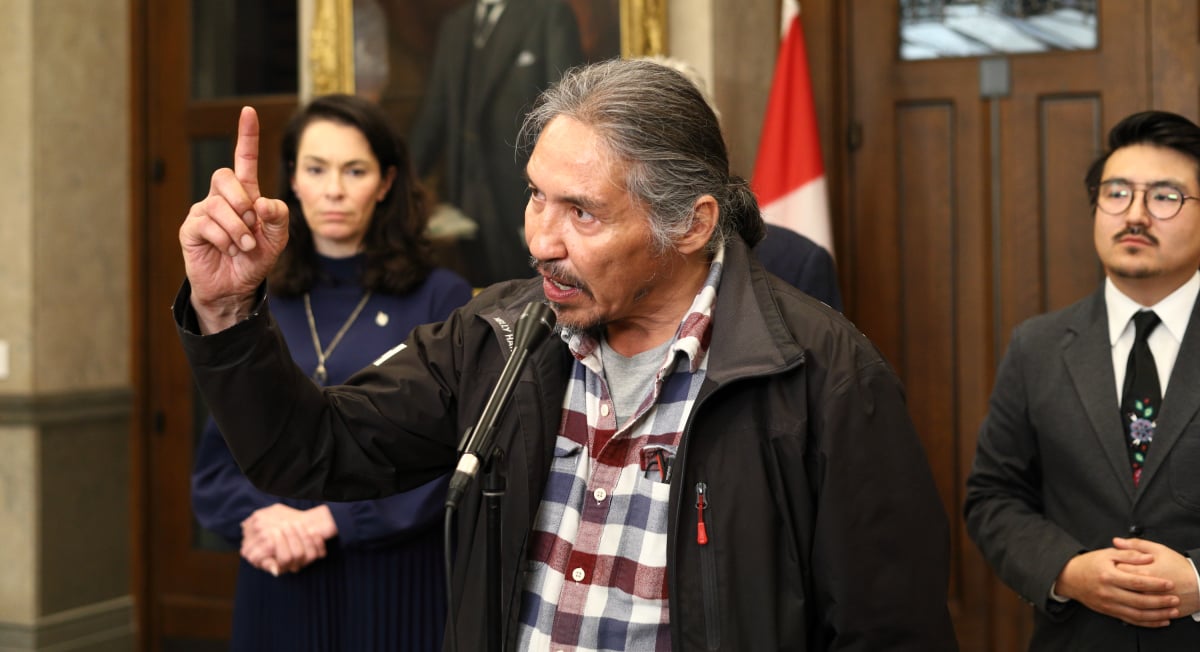Support strong Canadian climate journalism for 2025
The Athabasca Chipewyan First Nation has served the Alberta Energy Regulator’s president with a notice of a lawsuit.
The lawsuit focuses on the regulator’s failure to notify the nation about two large leaks of toxic tailings from Imperial Oil’s Kearl site in northern Alberta, according to an ACFN press release.
“We're seeking environmental reform here in Alberta,” said Chief Allan Adam in a phone interview with Canada’s National Observer. “We want to sit at the table, we want to be part of the decision-making powers when it comes to the regulator process.”
Adam personally served the regulator’s president and CEO Laurie Pushor with papers at a tumultuous meeting between community members and AER representatives on Tuesday evening in Fort Chipewyan, Alta.
“Now that they've messed up so bad that we have them … we're going to expose all of the negligence that they've been doing over the years,” said Adam. He left the meeting shortly after handing Pushor the statement of claim at the advice of ACFN’s lawyers.
The lawsuit, filed in Alberta Court of King’s Bench, seeks a declaration that the province’s regulations and policies for managing oilsands tailings are deficient and unconstitutional and enabled tailings leaks to go unreported for months. ACFN is also seeking damages of $500 million for the regulator’s “negligence, breach of duty to consult and treaty infringement,” according to the notice of claim.
In an emailed statement to Canada’s National Observer, AER media relations said the regulator “will be seeking legal advice.”
“We appreciate the opportunity to visit Fort Chipewyan and to meet and speak with the community,” the AER’s short statement said.
Back in September, Adam told Canada’s National Observer that AER should “prepare for court” after a third-party review commissioned by the regulator on how the tailings leaks were handled concluded the regulator acted responsibly. On March 5, Adam made good on that threat.
“The AER is supposed to regulate the energy sector in Alberta to ensure safety and environmental responsibility,” said Adam in his press release. “They have spectacularly failed on this front.” He added the AER neglected the nation’s constitutional right to be consulted and accommodated.
The statement of claim says the leaks at Kearl are “not isolated incidents, but rather symptoms of broader deficiencies” in the province’s regulatory and legal regime for tailings management and other energy project approvals. In particular, the AER’s decisions over tailings management do not require consultation with First Nations despite possible adverse impacts to their rights, said the court document.
The AER had a duty to warn ACFN about the tailings leaks on Imperial Oil’s Kearl site and by failing to do so, harmed community members’ ability to exercise their treaty rights, according to the statement of claim. This includes activities like hunting, fishing, gathering and widespread use of ACFN’s traditional territory and natural resources. It also described the “fear and anxiety” community members felt about the water supply when news first broke that Kearl had been leaking tailings for nine months.
When asked about possible legal action against Imperial Oil, Adam said they “looked at all those options” and there wasn’t grounds to pursue it because the company followed the guidelines.
“But the AER left themselves vulnerable … and these are the people [who] we need to go after because they are responsible for the development that's going on here in Alberta,” said Adam. “It's time now that they're being held accountable.”
Early last year, it came to light tailings were seeping from Imperial Oil’s Kearl site in northern Alberta for nine months, and apart from one email, downstream communities were not notified. It took a massive spill of 5.3 million litres on Feb. 4, 2023 for the long-term seepage — which Imperial Oil first noticed in May 2022 — to be made public through an environmental protection order, sparking outrage from Indigenous communities, the public and politicians.
The issue made international headlines and a federal committee spearheaded a study on the tailings leaks and questioned Imperial Oil executives, the Alberta Energy Regulator and affected groups and communities, including the ACFN and Mikisew Cree First Nation, about the incidents. Imperial Oil and the AER characterize the issue as a communications breakdown. Imperial Oil CEO Brad Corson has said repeatedly the seepage didn’t reach the waterways and there is no indication of adverse impacts to human life, wildlife, vegetation or fish populations in nearby river systems from the incidents.
The lawsuit also wants the court to order the province to turn over all or some of the royalties it received from the Kearl project — estimated at roughly $50 million per month — between May 2022 and November 2023 to ACFN.
"It is not right for the Crown to benefit from the project while ACFN was being actively and unlawfully harmed by it," Kevin Hille, one of ACFN's lawyers and a partner at Olthuis, Kleer and Townshend, told Canada’s National Observer in an emailed statement.
It is technically possible for other nations and communities to join the lawsuit but at the time of publication, Canada’s National Observer is not aware of any additions.
“We leave that door open because there are a lot of people out there [who] are concerned in regards to what's going on with the development here in northern Alberta,” said Adam.
The Kearl leaks shone a light on the ever-growing volume of toxic tailings — a byproduct of processing bitumen from the oilsands — being held in human-made lakes near the Athabasca River. These massive ponds hold more than 1.4 trillion litres of toxic waste and are set to hit capacity in 2025, at which point, the tailings will be treated and dumped in the river unless a different solution is found.
Environmental reform is needed because most of the activities industry applies for occur on traditional territories of Aboriginal people, said Adam.
“If we had Aboriginal representation at these tables and everything, then we would have a say in regards to how development is occurring. But right now, we have no say,” he said.
Other people make decisions on our behalf “and it's causing havoc, it's causing health concerns in our community, and nobody's addressing those issues,” added Adam. He said as long as those issues continue to fester, his nation will remain a thorn in the province’s side.
ACFN and Mikisew Cree First Nation called for the AER to be dismantled during the parliamentary hearings last year, calling it a captured regulator. Daniel Stuckless, director of the Fort McKay Métis Nation, told the committee he thinks the regulator is unsalvageable in its current form.
“We're not going to stop. We waited 20 years for this to happen, regardless of the situation, and this is our opportunity to make sure that the Alberta government and the … energy regulators are held accountable for their actions in regards to reporting and to protect the communities that are supposed to be protected by them,” said Adam.
The AER has 20 days to respond to the statement of claim.
Natasha Bulowski / Local Journalism Initiative / Canadaès National Observer
This article was updated at 4pm ET on March 6 to include comment from ACFN Chief Allan Adam and additional information about the lawsuit




Comments
The social media backlash to this lawsuit in Alberta will no doubt be aided and abetted by the Conservative Party's reaction, without any doubt filled to the brim with disguised racism, innuendo, lies and misinformation, just like their official party releases on fossil fuel industry greenwashing.
If there is any cause to donate to a cause for justice in Alberta, let it be to assist this First Nation along the long legal road ahead
Indigenous communities downstream from the oilsands have a long, long history of being subjected to the toxins permeating their water and food sources. It has been documented decades ago by scientists, whose work was covered up and whose reputations were besmirched by a succession of Alberta governments.
To all CNO readers, please consider donating to this First Nation in this fight whose financial resources are very limited, to counter the extensive legal and PR resources of Alberta and its deep pocketed oil industry donors.
About damn time! I hope Alberta's indigenous downstream victims of poisoning don't have to wait as long for redress as the "downwind" victims of radiation poisoning have waited/are still waiting